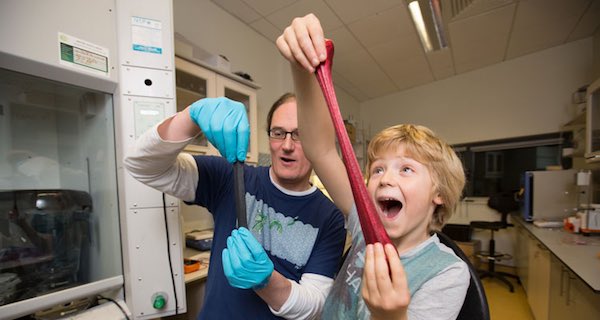
[Image above] Trinity College Dublin researcher Johnny Coleman investigates G-Putty, but his son Oisin prefers Silly Putty. Credit: AMBER, Trinity College Dublin
A group out of Trinity College Dublin in Ireland published a paper in Science last Friday that’s been getting a lot of attention.
The coolness of the science is hidden behind the title’s big words: “Sensitive electromechanical sensors using viscoelastic graphene-polymer nanocomposites.”
Translation: mixing graphene with homemade “Silly Putty” makes a composite with very cool properties.
In the video below, Trinity College physics professor and lead scientist Jonathon Coleman explains, “When you took the composite… and you squashed it or deformed it in any way its electrical resistance would change dramatically,” which would make it useful as an electromechanical sensor. The researchers found it has a “sensitivity factor of up to 500—hundreds of times better than a strain sensor,” according to Coleman.
Credit: AMBER Centre; YouTube
How sensitive is that? Reports are that it can sense footsteps of a spider walking across it.
While arachnid zookeepers and researchers may rejoice at having found a sensor that will keep the little monsters from making a jailbreak, there are practical applications in the biomedical arena that could be disruptive.
For example, Coleman’s group shows in the video that pulse and blood pressure can be monitored easily by placing the material over the carotid artery and measuring the electromechanical response. Sure, there are plenty of existing techniques, but Coleman notes that the ability to measure blood pressure continuously is a breakthrough.
It’s easy to imagine the usefulness of such a tool in triage or surgery situations. Break open a band-aid-like package, slap it on the victim’s neck, and plug into a computer, which monitors and records vital signs while the paramedic turns attention to other issues. With the Internet of Things, those vitals could be reported to a remote site like a hospital emergency center.
The authors also suggest a possible application as an impact sensor. Most product development engineers have a number of applications rolling through their minds by now.
So why does it work? The sensitivity results from a sharp increase in resistance with applied strain. The resistance decays very slowly compared to the rate at which stress relaxes. The paper explains, “We interpret this behavior as the strain rapidly deforming the network and breaking nanosheet–nanosheet connctions, thus increasing the resistance.”
In addition, the researchers hypothesize that the nanosheets themselves have some mobility. “This network relaxation can be thought of as a self-healing process,” although they note that the deformation is not fully reversible. Eventually, the material will lose sensitivity.
Nonetheless, the upside potential of this super-simple composite is huge.
“It shows the power of nanomaterials—a small amount of nano can turn something ordinary into something extraordinary,” Coleman modestly concludes in the video.
The paper, published in Science (subscription required) on Dec. 9, 2016, is “Sensitive electromechanical sensors using viscoelastic graphene-polymer nano composites,” (DOI: 10.1126/science.aag2879).
